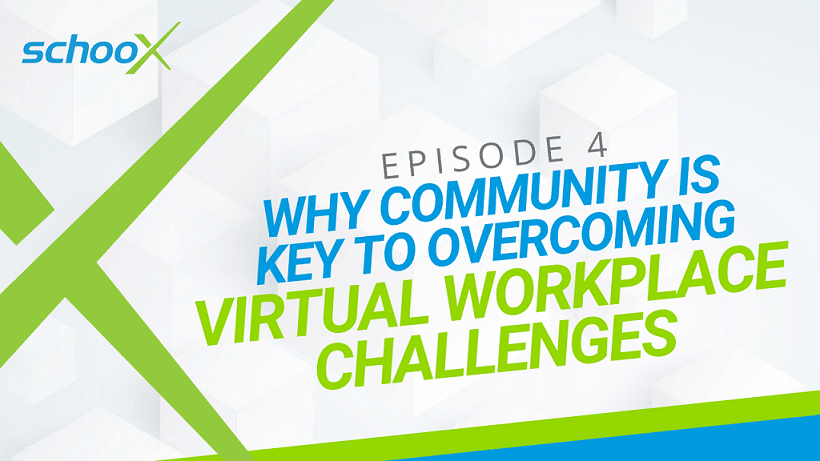30 October 2020
5

How has the pandemic impacted your workplace?
The learning and development community has adapted quickly and efficiently in the face of the pandemic. The shift to remote learning remains one of the most impactful changes that this industry has ever seen. But what side effects have the community experienced as a result of this?
In this episode of The Learning Xchange, Matthew Brown, the VP of Learning and Brand Success at Schoox, talks about the importance of community in overcoming the challenges of the virtual workplace. He discusses why you should prioritize communication, practice empathetic management, and why community is key to overcoming virtual workplace challenges.
Hit play to listen to this episode of the podcast below:
Or, find out more by reading on.
How to overcome remote working issues
The move to remote working is one of the greatest changes that the learning and development community has ever experienced.
People accepted the necessary, sudden change with varying degrees of excitement in the beginning. However, what might have been a dream come true for some was a nightmare for others.
The issue with remote working is that it creates pressures that don’t exist in a physical workplace.
One of the first problems you might need to tackle is finding an adequate space to insulate and work without interruptions. You might have children, family members, pets, or other distractions that could impact your ability to work effectively. There might be technical challenges, or you might not have access to the equipment that helps you meet the job’s demands.
Many businesses have taken steps to ensure that their employees can build a home office that sets them up for success. But creating a suitable home working environment is more than having the correct equipment.
If you’re an experienced remote worker, you’ll have created an environment where you can stay productive and consistently contribute to your company’s progress. However, if you’re new to remote working, you should learn how to communicate virtually with your managers and your team. This includes letting them know when you need support.
It’s this social aspect that is a core component of a successful workplace. Unfortunately, it’s greatly affected by the shift to a virtual workplace environment.
Why managers need to approach leadership with empathy
In an office space or physical work environment, you can read the room and your team’s body language to see how they feel. In a virtual workspace, this becomes much more difficult to do.
It’s easy to become disconnected from the support that other people might need to succeed in the digital world. It’s challenging to understand how your team feels, what their challenges might be, and if they need more help.
The drastic and demanding changes within the learning industry can impact employee attitudes, behaviors, productivity. They also significantly increase the chances of burnout. Managers are usually encouraged to monitor these employees closely in a “normal” work environment. But how can you manage this situation virtually?
Digital environments require a new form of leadership. It’s more vital than ever to cultivate a safe, digital space where your team members feel comfortable conveying how they’re feeling.
This is a very difficult thing to achieve. It’s not easy for people to admit when they’re struggling, especially when many people are now concerned about losing their jobs. Many jobs and businesses face uncertainty, with furlough schemes, layoffs, and restructurings still prominent across the learning and development industry.
Employees may not want to admit they’re finding the challenges difficult, so it takes a flexible, personalized, and empathetic management approach to ensure that your employees are supported effectively.
Why training modalities should adapt to overcome virtual workplace challenges
You can support your employees by helping them build their skills. Skills such as collaboration, creativity, communication, flexibility, and dealing with stress, can help employees manage their workloads and other virtual workplace challenges.
These “soft skills” are crucial to your team’s success. Trainers and businesses are now taking into account how they can develop training courses to improve these skills.
However, training courses need to diversify more broadly in order to serve all learners effectively. Workforces are more diverse than ever with multi-generational and multi-dimensional teams, so training delivery mechanisms must adapt accordingly.
Could you deliver your training across new modalities? Or could you create new content that addresses the different needs that learners have? It’s important to consider the new challenges that everyone faces and adapt your training to overcome them.
Why community is key to overcoming virtual workplace challenges
Training can do more than deliver knowledge to people. Learning experiences and training activities can build communities. These relationships present collaboration opportunities that can further your learning and your business.
Tapping into this power of social and informal learning is a great way to continue your team’s development. But it’s a challenge to achieve this virtually.
Social learning happens naturally in a physical workspace, as people exchange thoughts and ideas in conversation. Businesses should proactively make space for this in the virtual workplace too. You could achieve this by implementing video conference team meetings, one-to-one calls, or setting up a virtual space for sharing ideas.
Collectively tackling virtual workplace challenges is much more effective than facing them individually. You can set your employees up for success by encouraging them to communicate and collaborate.
The learning and development community has always excelled at collaborating. Now, connecting to your community has never been more important.
At Schoox, we want to encourage you to connect with other professionals in the community. We encourage you to join a local or online learning and development community to support you and where you can share your ideas and experiences.
If you’re not sure where to start, begin by connecting with us on social media. We’re @Schoox on Twitter, Facebook, and LinkedIn.
If you liked the summary of this podcast episode, check out episode three, How the Learning and Development Community Is Successfully Navigating the Pandemic.
Thank you for reading about The Learning Xchange, the podcast from Schoox. The Learning Xchange is our weekly feature that focuses on the ever-changing landscape of online learning and talent management. It’s available to access here, on our website, as blogs or podcasts, or as video episodes on YouTube.
RELATED RESOURCES



